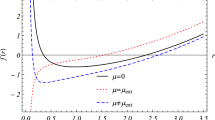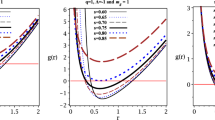Abstract
Supposing the existence of modified Chaplygin gas with the equation of state \(p=A\rho -B/\rho ^\beta\) as a cosmic background, we obtain a static spherically symmetric solution to the Einstein–Gauss–Bonnet gravitational equations in 5D spacetime. The spacetime structure of the obtained black hole solution could be asymptotically anti-de Sitter or de Sitter, according to the specific values of modified Chaplygin gas parameters versus the cosmological constant. We analyze the parametric regions for both kinds of solutions. For asymptotically anti-de Sitter black hole, there exists the so-called small/large black hole phase transition, and we obtain critical values of pressure, volume and temperature and investigate the effects of both the Gauss–Bonnet gravity and the modified Chaplygin gas on these values. For asymptotically de Sitter black hole, no \(P-r_{\mathrm{h}}\) criticality and phase transition appear, and we show that the thermodynamic systems related to various horizons of asymptotically de Sitter black hole are in fact entangled.






Similar content being viewed by others
Data Availability
There are no data associated in the manuscript.
References
D. Lovelock, The Einstein tensor and its generalizations. J. Math. Phys. 12, 498 (1971)
D. Lovelock, The four-dimensionality of space and the Einstein tensor. J. Math. Phys. 13, 874 (1972)
B. Zwiebach, Curvature squared terms and string theories. Phys. Lett. B 156, 315 (1985)
D.J. Gross, E. Witten, Superstring modifications of Einstein’s equations. Nucl. Phys. B 277, 1 (1986)
R.R. Metsaev, A.A. Tseytlin, Two-loop \(\beta\)-function for the generalized bosonic sigma model. Phys. Lett. B 191, 354 (1987)
R.R. Metsaev, A.A. Tseytlin, Curvature cubed terms in string theory effective actions. Phys. Lett. B 185, 52 (1987)
K.S. Stelle, Classical gravity with higher derivatives. Gen. Relat. Gravit. 9, 353 (1978)
J.W. Maluf, Conformal invariance and torsion in general relativity. Gen. Relat. Gravit. 19, 57 (1987)
M. Farhoudi, On higher order gravities, their analogy to GR, and dimensional dependent version of Duff’s trace anomaly relation. Gen. Rel. Grav. 38, 1261 (2006). arXiv: physics/0509210
D.G. Boulware, S. Deser, String-generated gravity models. Phys. Rev. Lett. 55, 2656 (1985)
B. Zumino, Gravity theories in more than four dimensions. Phys. Rept. 137, 109 (1986)
R.C. Myers, Superstring gravity and black holes. Nucl. Phys. B 289, 701 (1987)
C.G. Callan Jr., R.C. Myers, M.J. Perry, Black holes in string theory. Nucl. Phys. B 311, 673 (1989)
Y.M. Cho, I.P. Neupane, P.S. Wesson, No ghost state of Gauss-Bonnet interaction in warped background. Nucl. Phys. B 621, 388 (2002). arXiv: hep-th/0104227
R.G. Cai, Gauss-Bonnet black holes in AdS spaces. Phys. Rev. D 65, 084014 (2002). arXiv: hep-th/0109133
J.T. Wheeler, Symmetric solutions to the Gauss–Bonnet extended Einstein equations. Nucl. Phys. B 268, 737 (1986)
Y.M. Cho, I.P. Neupane, Anti-de Sitter Black holes, thermal phase transition and holography in higher curvature gravity. Phys. Rev. D 66, 024044 (2002). [arXiv: hep-th/0202140]
R.G. Cai, Q. Guo, Gauss-bonnet black holes in ds spaces. Phys. Rev. D 69, 104025 (2004). [arXiv: hep-th/0311020]
G. Dotti, J. Oliva, R. Troncoso, Exact solutions for the Einstein–Gauss–Bonnet theory in five dimensions: black holes, wormholes and spacetime horns. Phys. Rev. D 76, 064038 (2007). [arXiv: hep-ph/0706.1830]
D.D. Doneva, S.S. Yazadjiev, New Gauss–Bonnet Black holes with curvature-induced scalarization in extended scalar–tensor theories. Phys. Rev. Lett. 120, 131103 (2018). [arXiv: gr-qc/1711.01187]
H.O. Silva, J. Sakstein, L. Gualtieri, T.P. Sotiriou, E. Berti, Spontaneous scalarization of black holes and compact stars from a Gauss–Bonnet coupling. Phys. Rev. Lett. 120, 131104 (2018). [arXiv: gr-qc/1711.02080]
J.L. Blzquez-Salcedo, D.D. Doneva, J. Kunz, S.S. Yazadjiev, Radial perturbations of the scalarized Einstein–Gauss–Bonnet black holes. Phys. Rev. D 98, 084011 (2018). [arXiv: gr-qc/1805.05755]
C.F.B. Macedo, J. Sakstein, E. Berti, L. Gualtieri, H.O. Silva, T.P. Sotiriou, Self-interactions and spontaneous black hole scalarization. Phys. Rev. D 99, 104041 (2019). [arXiv: gr-qc/1903.06784]
D.D. Doneva, K.V. Staykov, S.S. Yazadjiev, Gauss–Bonnet black holes with a massive scalar field. Phys. Rev. D 99, 104045 (2019). [arXiv: gr-qc/1903.08119]
N. Aghanim [Planck Collaboration], Planck, et al. Results (VI, Cosmological parameters, 2018). [arXiv: astro-ph/1807.06209]
V.V. Kiselev, Quintessence and black holes. Class. Quant. Grav. 20, 1187 (2003). [arXiv: gr-qc/0210040]
C.R. Ma, Y.X. Gui, F.J. Wang, Quintessence contribution to a Schwarzschild black hole entropy. Chin. Phys. Lett. 24, 3286 (2007)
S. Fernando, Schwarzschild black hole surrounded by quintessence: Null geodesics. Gen. Rel. Grav. 44, 1857 (2012). [arXiv: gr-qc/1202.1502]
Z. Feng, L. Zhang, X. Zu, The remnants in Reissner–Nordstr\(\ddot{o}\)m-de Sitter quintessence black hole. Mod. Phys. Lett. A 29, 1450123 (2014)
B. Malakolkalami, K. Ghaderi, Schwarzschild-anti de Sitter black hole with quintessence. Astrophys. Space Sci. 357, 112 (2015)
I. Hussain, S. Ali, Effect of quintessence on the energy of the Reissner–Nordstr\(\ddot{o}\)m black hole. Gen. Rel. Grav. 47, 34 (2015). [arXiv: gr-qc/1408.3111]
S.G. Ghosh, M. Amir, S.D. Maharaj, Quintessence background for 5D Einstein–Gauss–Bonnet black holes. Eur. Phys. J. C 77, 530 (2017). [arXiv: gr-qc/1611.02936]
S.G. Ghosh, S.D. Maharaj, D. Baboolal, T.H. Lee, Lovelock black holes surrounded by quintessence. Eur. Phys. J. C 78, 90 (2018). [arXiv: gr-qc/1708.03884]
J. de M. Toledo, V. B. Bezerra, Black holes with cloud of strings and quintessence in Lovelock gravity. Eur. Phys. J. C 78, 534 (2018)
A.E. Dominguez, E. Gallo, Radiating black hole solutions in Einstein–Gauss–Bonnet gravity. Phys. Rev. D 73, 064018 (2006). [arXiv: gr-qc/0512150]
D. Wiltshire, Black holes in string-generated gravity models. Phys. Rev. D 38, 2445 (1988)
H. Maeda, M. Hassaine, C. Martinez, Lovelock black holes with a nonlinear Maxwell field. Phys. Rev. D 79, 044012 (2009). [arXiv: gr-qc/0812.2038]
S.H. Hendi, S. Panahiyan, E. Mahmoudi, Thermodynamic analysis of topological black holes in Gauss–Bonnet gravity with nonlinear source. Eur. Phys. J. C 74, 3079 (2014). [arXiv: gr-qc/1406.2357]
S. Habib Mazharimousavi, M. Halilsoy, 5D black hole solution in Einstein-Yang-Mills-Gauss-Bonnet theory. Phys. Rev. D 76, 087501 (2007) [arXiv: gr-qc/0801.1562]
E. Herscovich, M.G. Richarte, Black holes in Einstein–Gauss–Bonnet gravity with a string cloud background. Phys. Lett. B 689, 192 (2010). [arXiv: hep-th/1004.3754]
A.Y. Kamenshchik, U. Moschella, V. Pasquier, An alternative to quintessence. Phys. Lett. B 511, 265 (2001). [arXiv: gr-qc/0103004]
N. Bilic, G.B. Tupper, R.D. Viollier, Unification of dark matter and dark energy: the Inhomogeneous Chaplygin gas. Phys. Lett. B 535, 17 (2002). [arXiv: astro-ph/0111325]
M.C. Bento, O. Bertolami, A.A. Sen, Generalized Chaplygin gas, accelerated expansion and dark energy-matter unification. Phys. Rev. D 66, 043507 (2002). [arXiv: gr-qc/0202064]
D. Carturan, F. Finelli, Cosmological effects of a class of fluid dark energy models. Phys. Rev. D 68, 103501 (2003). [arXiv: astro-ph/0211626]
L. Amendola, F. Finelli, C. Burigana, D. Carturan, WMAP and the generalized Chaplygin gas. JCAP 0307, 005 (2003). [arXiv: astro-ph/0304325]
R. Bean, O. Dore, Are Chaplygin gases serious contenders to the dark energy throne? Phys. Rev. D 68, 023515 (2003). [arXiv: astro-ph/0301308]
N. Ogawa, A Note on classical solution of Chaplygin gas as d-branes. Phys. Rev. D 62, 085023 (2000). [arXiv: hep-th/0003288]
X.Q. Li, B. Chen, L.l. Xing, Charged Lovelock black holes in the presence of dark fluid with a nonlinear equation of state. [arXiv: gr-qc/1905.08156]
H.B. Benaoum, Accelerated universe from modified Chaplygin gas and tachyonic fluid. [arXiv: hep-th/0205140]
U. Debnath, A. Banerjee, S. Chakraborty, Role of modified Chaplygin gas in accelerated universe. Class. Quant. Grav. 21, 5609 (2004). [arXiv: gr-qc/0411015]
T. Torii, H. Maeda, Spacetime structure of static solutions in Gauss–Bonnet gravity: neutral case. Phys. Rev. D 71, 124002 (2005). [arXiv: hep-th/0504127]
T. Torii, H. Maeda, Spacetime structure of static solutions in Gauss–Bonnet gravity: charged case. Phys. Rev. D 72, 064007 (2005). [arXiv: hep-th/0504141]
R.M. Wald, Black hole entropy is the Noether charge. Phys. Rev. D 48, R3427 (1993)
C. Sahabandu, P. Suranyi, C. Vaz, L.C.R. Wijewardhana, Thermodynamics of static black objects in D dimensional Einstein–Gauss–Bonnet gravity with D-4 compact dimensions. Phys. Rev. D 73, 044009 (2006). [arXiv: gr-qc/0509102]
M. Angheben, M. Nadalini, L. Vanzo, S. Zerbini, Hawking radiation as tunneling for extremal and rotating black holes. JHEP 0505, 014 (2005). [arXiv: hep-th/0503081]
R. Kerner, R.B. Mann, Tunnelling, temperature and Taub-NUT black holes. Phys. Rev. D 73, 104010 (2006). [arXiv: gr-qc/0603019]
B. Iyer, S. Iyer, C. Vishveshwara, Scalar waves in the Boulware–Deser black-hole background. Class. Quant. Grav. 6, 1627 (1989)
C.M. Harris, P. Kanti, Hawking radiation from a (4+n)-dimensional black hole: exact results for the Schwarzschild phase. JHEP 0310, 014 (2003). [arXiv: hep-ph/0309054]
V. Cardoso, M. Cavaglia, L. Gualtieri, Hawking emission of gravitons in higher dimensions: non-rotating black holes. JHEP 0602, 021 (2006). arXiv: hep-ph/0512116]
A.S. Cornell, W. Naylor, M. Sasaki, Graviton emission from a higher-dimensional black hole. JHEP 0602, 012 (2006). arXiv: hep-ph/0510009]
A.S. Cornell, W. Naylor, M. Sasaki, Graviton emission from a higher-dimensional black hole. JHEP 0602, 012 (2006). arXiv:hep-ph/0510009
D. Kubiznak, F. Simovic, Thermodynamics of horizons: de Sitter black holes and reentrant phase transitions. Class. Quant. Grav. 33(24), 245001 (2016). arXiv:hep-ph/1507.08630
Acknowledgements
This work is partly supported by the Special Foundation for Theoretical Physics Research Program of China (Grant No. 11847065) and the Natural Science Foundation of Shanxi Province (No. 201901D211110).
Author information
Authors and Affiliations
Corresponding author
A Einstein–Gauss–Bonnet black holes in D-dimensional spacetime
A Einstein–Gauss–Bonnet black holes in D-dimensional spacetime
The energy density of the modified Chaplygin gas shows
The solution for the metric function is obtained as
with
where \(\Sigma _{D-2}\) denotes the volume of the unit \((D-2)\) sphere. Again, only the minus branch solution \(f_{-}(r)\) is considered as a black hole solution.
The black hole horizon \(r_{\mathrm{h}}\) for asymptotically anti-de Sitter solutions satisfies \(f_-(r_{\mathrm{h}})=0\), while the black hole horizon \(r_{\text {b}}\), cosmological horizon \(r_c\) and inner horizon \(r_i\) for asymptotically de Sitter solutions satisfy the equation \(f_-(r_{b,c,i})=0\). The ADM mass of the black hole in terms of the several horizons reads
According to Eq. (41), the three horizons of asymptotically de Sitter black hole are entangled. The Hawking temperatures associated with different horizons are calculated as
with
The entropies are given by
The Gibbs free energies related to different horizons are identified as
Rights and permissions
Springer Nature or its licensor (e.g. a society or other partner) holds exclusive rights to this article under a publishing agreement with the author(s) or other rightsholder(s); author self-archiving of the accepted manuscript version of this article is solely governed by the terms of such publishing agreement and applicable law.
About this article
Cite this article
Li, XQ., Chen, B. & Xing, LL. Black holes in Einstein–Gauss–Bonnet gravity with a background of modified Chaplygin gas. Eur. Phys. J. Plus 137, 1167 (2022). https://doi.org/10.1140/epjp/s13360-022-03379-y
Received:
Accepted:
Published:
DOI: https://doi.org/10.1140/epjp/s13360-022-03379-y




